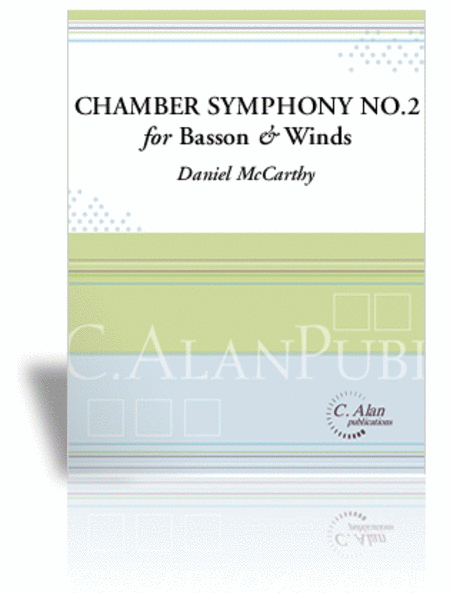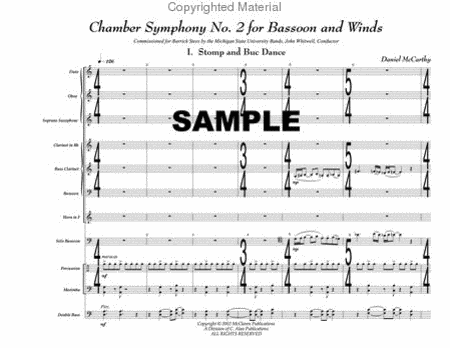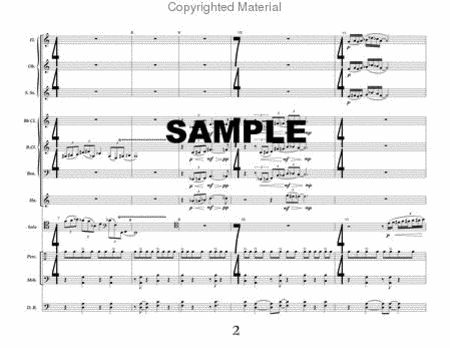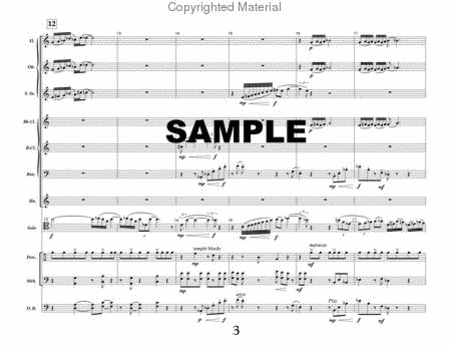Chamber Symphony No. 2 for Bassoon
Bassoon Feature
-
Ships in 3 to 4 weeks
Details
Description
SKU: CN.05860
Bassoon Feature. Composed by Daniel McCarthy. Score and parts. Duration 16:00. Published by C. Alan Publications (CN.05860).The title "Chamber Symphony" indicates that "the wind ensemble is more intimately involved (musically speaking) with the soloist than a accompaniment as in a concerto. In this regard, the single winds and bassoon are treated integrally although the bassoon is the featured instrument.
Chamber Symphony No. 2 for Bassoon and Winds was commissioned for Barrick Stees by the Michigan State University Bands, John Whitwell, Conductor. This piece follows the format of McCarthy's Chamber Symphony (No. 1) for Marimba and Winds, a virtuosic composition for solo instrument and chamber ensemble that has more musically involved accompaniment than implied by the term 'concerto.' Daniel McCarthy met Barrick Stees as a colleague at the Interlochen Summer Arts Festival (Interlochen Arts Camp, Interlochen, Michigan) in the summer of 1995. Since that time, McCarthy and Stees have worked together on numerous recording and performance projects - most recently, the recording of another commissioned work of McCarthy's by Stees, All the West Was Moving (Centaur Records: Barrick Stees and The Arianna String Quartet). For Chamber Symphony No. 2, McCarthy prefers the multi-movement format, six movements of varying lengths. Similar to some of Beethoven's late string quartets, McCarthy uses two shorter movements as introductions to others, namely the two 'Interludes.' The outer two movements are programmatic, whereas the interior movements are much more classically conceived. Movement 1: 'Stomp and Buc Dance' Having grown up in Northern Michigan, McCarthy has a special affinity for the autumn season. Several of his teachers from the Interlochen Academy (where McCarthy graduated in 1974) are avid hunters. The deer-hunting season for many in northern Michigan is sacred. One hears of the so-called 'deer camps' where hunters have wild parties (far enough from their hunting sites as to not 'spook' the animals). McCarthy imagines Deer, Buck, and Elk parties at the end of hunting season, when the animals, after another season of successfully avoiding the hunters' bullets and arrows, dance wildly around their own camp fires, drinking deer-beer and mocking the hunters in the dim fire light. Movement 2: 'Interlude' 'Interlude' introduces a softer, darker, less humorous music than the first movement. It offers a transition to a much less programmatic third movement in comparison to the first. Movement 3: 'Mechanique' 'Mechanique' is a study in angular intervals for the solo bassoon. The rhythmic animation in the solo with the motoric doublebass and marimba accompaniments give the music a mechanical sound that is (perhaps) associated with an etude. Movement 4: 'Interlude: Creep' The second 'Interlude,' this time with the subtitle: 'Creep' is inspired by the second movement of J. S. Bach's Suite No. 3 in D Major (Air on the G String). The inspiration for this interlude is textural: a long, sustained melody in the treble above a punctuated, quasi-jazz pizzicato bass and marimba bass line that 'creeps' and crawls its way beneath the ensemble. It is the only movement without the bassoon solo. Movement 5: 'Static' A somewhat improvisational, rhapsodic sounding piece, 'Static' is a study in repeated notes and fast tonguing for the wind instruments. The 'static' repetition of pitches creates a percussive effect that is juxtaposed with a mosaic of wide-interval motives. Movement 6: 'Fire, Dance, and Wahbekanetta' This movement, like the first, is about wild-eyed, nocturnal parties in Michigan's northern wood. In 1969, the composer attended the National Music Camp as a trumpet player and later, the Interlochen Arts Academy from 1970-1974. He later joined the faculty of Interlochen Arts Camp in 1995. McCarthy was born very near Interlochen, in a small village of Onekoma on Portage Lake. The summer is the time for the composer to return to the land of his youth, a chance to escape the rigors of academe, to be with friends. Memories are made around the dancing light of the 'fire-pit,' by the moonlight that illuminates Lake Wahekanetta.




 Share
Share